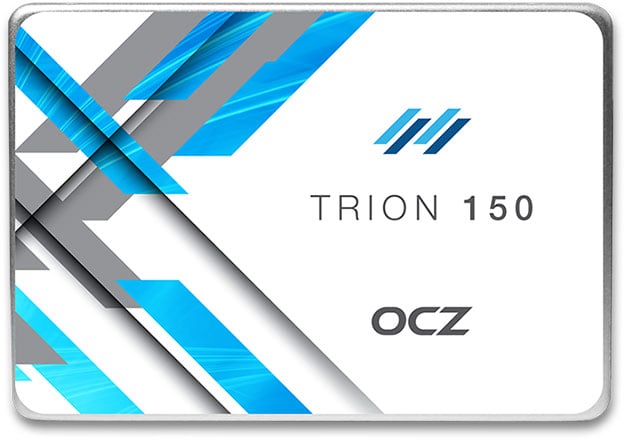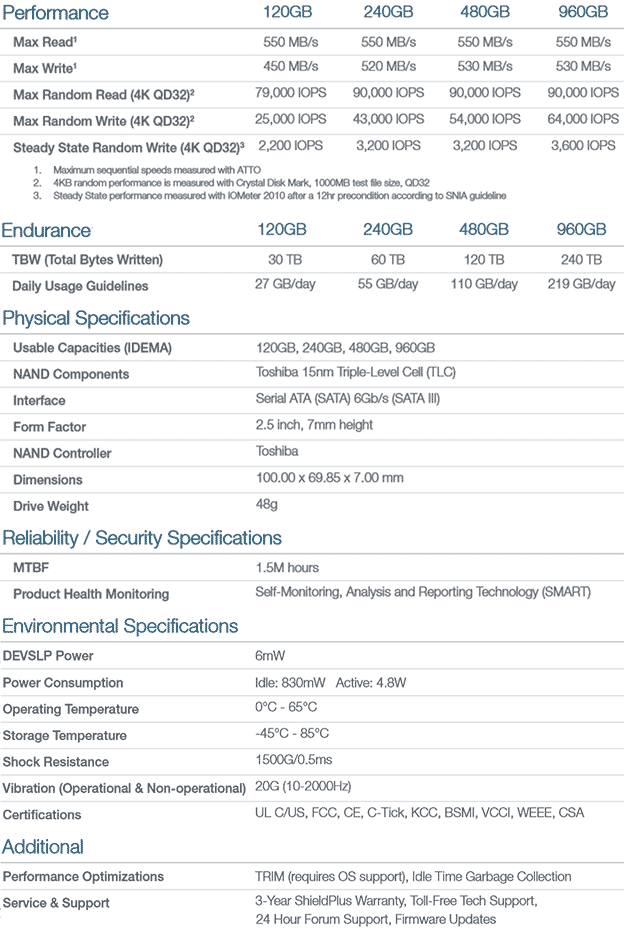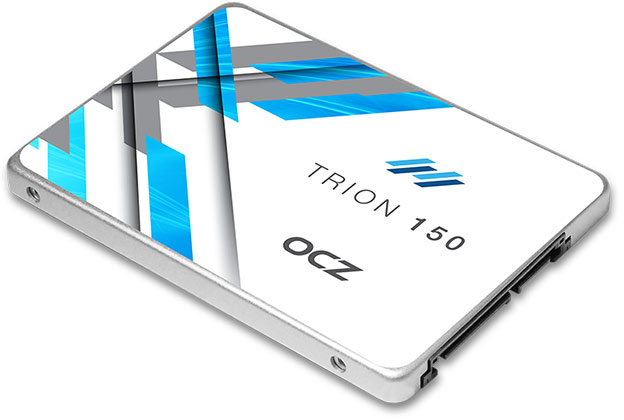OCZ Trion 150 SSD Review: Affordable, Fast Storage
OCZ Trion 150, Toshiba Powered SSD
The last time we saw OCZ, there were tearing up CES with an upcoming NVMe solid state drive that could transfer data at upwards of 2.7GB/s that was featured alongside a few new SATA-based solutions, like the Trion 150 series we’ll be showing you here today.
The OCZ Trion 150 is an update to last summer’s Trion 100, which was the first drive from OCZ to feature TLC NAND and all in-house, Toshiba-built technology. The Trion 100 series of drives proved to be good performers overall, especially considering their relatively affordable price points. As its branding suggests, the new Trion 150 kicks things up a few notches over the Trion 100, thanks to some cutting edge 15nm NAND flash memory and a tweaked firmware, that combined, offer increased performance over its predecessor.
Before we dig into what makes the OCZ Trion 150 tick, here’s a look at its main features and specifications, along with some performance expectations...
The new OCZ Trion 150 features a sturdy, anodized aluminum housing, just like the previous-generation Trion, though it’s not quite as rigid or hefty as some competing offerings. The enclosure isn’t held together with screws either (it snaps together) and it is definitely lighter weight than OCZ's Vector and Vertex series, as well as drives from Samsung or Intel.
All of the drives in Trion 150 family conform to the standard 2.5” form factor common to today’s SATA-based SSDs, and they all have slim 7mm Z-Heights. The enclosures used on the drives are all metal (top and bottom) and there are no stand-out external features to speak off, other than perhaps the custom decals and the SATA power and data connectors at one end. Those are par for the course with a drive of this type, though.
Pop open an OCZ Trion 150 and a blue PCB with Toshiba NAND and a Toshiba controller are revealed (these shots are of a 960GB drive). Unlike the Trion 100 which used A19nm NAND, the controller in the Trion 150 is paired to newer 15nm Toshiba TLC NAND Flash memory. There’s also some Micron DDR3 DRAM cache memory in there too (The Trion 100 we reviewed used Nanya). Details are scarce on the Toshiba TC58 controller, so we don’t have much to share in that regard. The controller does support Toshiba’s QSBC technology (Quadruple Swing-By Correction, which is a Toshiba proprietary error correction technology) and the drives can use a bit of NAND as an SLC cache to boost short-term write performance and increase endurance. The Trion 150 also support DEVSLP to save power when idle, though the drives do not support hardware encryption at this point.
Similar to many of OCZ’s previous consumer-class SSDs, the Trion 150s have about 6.25% of their NAND capacity over-provisioned, though this can be tweaked in the OCZ Guru utility that’s available as a free download from the company’s website. That additional capacity is reserved for wear-leveling and other proprietary features that aid the drives in achieving their endurance ratings.
The Trion 150 series drives are all rated for max read speeds of 550MB/s, but write performance varies between the models. The 120GB drive’s write performance peaks at 450MB/s, while the 240GB drives top out at 520MB/s. The higher capacities peak at 530MB/s. All of the drives support TRIM, as you would expect, but endurance ratings also differ based on capacity, ranging from 30TBW and 27GB/day on the 120GB drive on up to 240TBW and 219GB/day on the 960GB drive. Idle power is listed at 6mW (in DEVSLP) and active power at 4.8W, which is somewhat higher than many of OCZ’s enthusiast-class drives.
We should also mention that OCZ offers a 3 year warranty on these SSDs. And that warranty is of the OCZ “Shield Plus” variety, which the company describes as, “…an elite, worry-free customer service experience, which eliminates all the hassle surrounding traditional support and warranty claims consumers often have to deal with.” Provide OCZ Support with the drive’s serial number (no original purchase receipt is required), and in the event the drive is determined to be defective, it will be replaced with a brand new SSD. Advanced product replacement and a paid return shipping label are also provided to minimize downtime, should users need to take advantage of the warranty coverage.
The OCZ Trion 150 is an update to last summer’s Trion 100, which was the first drive from OCZ to feature TLC NAND and all in-house, Toshiba-built technology. The Trion 100 series of drives proved to be good performers overall, especially considering their relatively affordable price points. As its branding suggests, the new Trion 150 kicks things up a few notches over the Trion 100, thanks to some cutting edge 15nm NAND flash memory and a tweaked firmware, that combined, offer increased performance over its predecessor.
Before we dig into what makes the OCZ Trion 150 tick, here’s a look at its main features and specifications, along with some performance expectations...
|
The new OCZ Trion 150 features a sturdy, anodized aluminum housing, just like the previous-generation Trion, though it’s not quite as rigid or hefty as some competing offerings. The enclosure isn’t held together with screws either (it snaps together) and it is definitely lighter weight than OCZ's Vector and Vertex series, as well as drives from Samsung or Intel.
All of the drives in Trion 150 family conform to the standard 2.5” form factor common to today’s SATA-based SSDs, and they all have slim 7mm Z-Heights. The enclosures used on the drives are all metal (top and bottom) and there are no stand-out external features to speak off, other than perhaps the custom decals and the SATA power and data connectors at one end. Those are par for the course with a drive of this type, though.
Pop open an OCZ Trion 150 and a blue PCB with Toshiba NAND and a Toshiba controller are revealed (these shots are of a 960GB drive). Unlike the Trion 100 which used A19nm NAND, the controller in the Trion 150 is paired to newer 15nm Toshiba TLC NAND Flash memory. There’s also some Micron DDR3 DRAM cache memory in there too (The Trion 100 we reviewed used Nanya). Details are scarce on the Toshiba TC58 controller, so we don’t have much to share in that regard. The controller does support Toshiba’s QSBC technology (Quadruple Swing-By Correction, which is a Toshiba proprietary error correction technology) and the drives can use a bit of NAND as an SLC cache to boost short-term write performance and increase endurance. The Trion 150 also support DEVSLP to save power when idle, though the drives do not support hardware encryption at this point.
Similar to many of OCZ’s previous consumer-class SSDs, the Trion 150s have about 6.25% of their NAND capacity over-provisioned, though this can be tweaked in the OCZ Guru utility that’s available as a free download from the company’s website. That additional capacity is reserved for wear-leveling and other proprietary features that aid the drives in achieving their endurance ratings.
The Trion 150 series drives are all rated for max read speeds of 550MB/s, but write performance varies between the models. The 120GB drive’s write performance peaks at 450MB/s, while the 240GB drives top out at 520MB/s. The higher capacities peak at 530MB/s. All of the drives support TRIM, as you would expect, but endurance ratings also differ based on capacity, ranging from 30TBW and 27GB/day on the 120GB drive on up to 240TBW and 219GB/day on the 960GB drive. Idle power is listed at 6mW (in DEVSLP) and active power at 4.8W, which is somewhat higher than many of OCZ’s enthusiast-class drives.
We should also mention that OCZ offers a 3 year warranty on these SSDs. And that warranty is of the OCZ “Shield Plus” variety, which the company describes as, “…an elite, worry-free customer service experience, which eliminates all the hassle surrounding traditional support and warranty claims consumers often have to deal with.” Provide OCZ Support with the drive’s serial number (no original purchase receipt is required), and in the event the drive is determined to be defective, it will be replaced with a brand new SSD. Advanced product replacement and a paid return shipping label are also provided to minimize downtime, should users need to take advantage of the warranty coverage.










